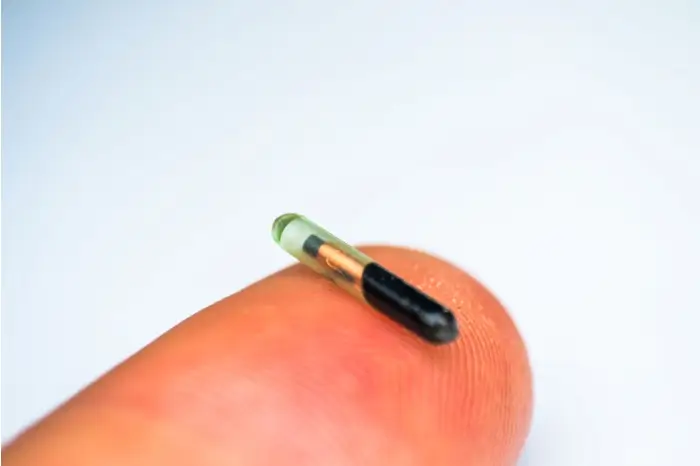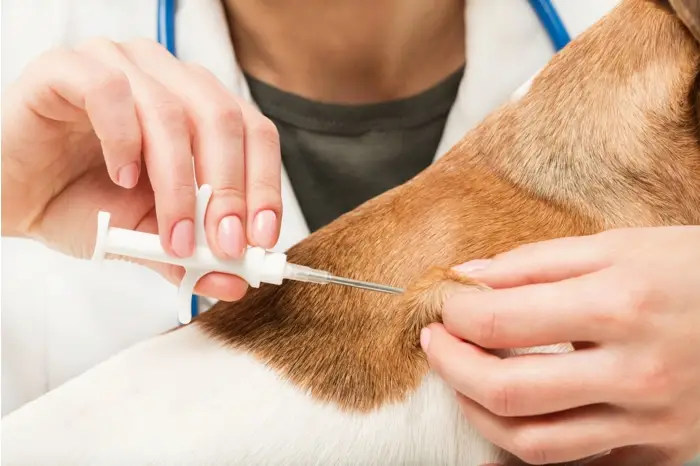Lost pets come home with Peeva.
The Chipped Dog: Understanding the Benefits of Microchipping Your Canine
We live in a world where technology is increasingly intertwined with every aspect of our lives, so it is not surprising that pet care and safety have been affected by it. Dog microchipping is one of the most notable advancements in this field, offering an extra layer of security for our pets. The purpose of this guide is to explain the ‘chipped dog’ concept and explore its workings and benefits.
What is a Chipped Dog?
A ‘chipped dog’ refers to a dog that has been implanted with a microchip, a small electronic device used for identification. The practice of microchipping pets began in the late 20th century and has since become a widely recognized method for keeping pets safe. The chip is typically injected under the skin, usually between the shoulder blades. Each microchip contains a unique identification number that can be read with a special scanner. The primary function of the chip is not to track the pet’s location but to provide a secure and permanent method of identification. This becomes invaluable if the dog is lost or stolen, as it can help reunite the dog with its owner quickly and efficiently.
Understanding RFID Technology in Dogs

The technology behind microchipping dogs is known as RFID, or Radio-Frequency Identification. RFID technology uses electromagnetic fields to automatically identify and track tags attached to objects, in this case, the microchip implanted in the dog. The microchip itself does not have a battery; it is passive and is only activated when a scanner is passed over it.
When the scanner is near the chip, it transmits radio waves that activate the chip, allowing it to transmit its unique identification number back to the scanner. This number, when checked against a pet recovery database, reveals the contact information of the dog’s owner. The advantages of RFID in pet identification are numerous. It provides a reliable and tamper-proof means of identification, unlike collars or tags that can be lost or removed. Additionally, the technology is non-invasive and generally safe, with minimal risk of complications.
How to Tell if a Dog is Chipped
For pet owners, knowing whether their dog is microchipped is crucial. The most straightforward way to determine if a dog is chipped is by visiting a veterinarian or a local animal shelter. These facilities are equipped with microchip scanners and can quickly check for the presence of a chip.
When a scanner is passed over the dog’s body, it will beep or display a number if a microchip is detected. It’s important for new pet owners, particularly those who have adopted their pets, to have this check done. If a chip is present, the next step is to ensure the microchip’s registration details are up-to-date, linking the unique number to the current owner’s contact information.
In some cases, pet adoption centres and breeders provide documentation indicating that the dog has been microchipped. However, it’s always wise to have this verified independently. In the absence of a microchip, pet owners should consider the benefits of having their dog chipped, given the peace of mind and security it offers.
The Process of Microchipping: Chip Puppy
Microchipping a puppy is a straightforward and relatively painless procedure that offers lifelong benefits. The ideal age for microchipping a puppy is typically around 8 to 10 weeks, coinciding with their first veterinary visits. Here’s how the process unfolds:
Veterinarian Consultation:
A veterinarian assesses the puppy’s health to ensure they are fit for the procedure.
Implantation:
The microchip, encased in a sterile applicator, is injected under the loose skin between the puppy’s shoulder blades. The process is quick and is similar to a routine vaccination.
Registration:
After implantation, the unique microchip number is registered along with the owner’s contact details in a national pet recovery database. This step is crucial for the microchip to be effective.
Post-Implantation Care:
Generally, there are no extensive aftercare requirements. Monitoring the implantation site for any signs of redness or swelling is advisable.
Microchipping at a young age ensures that puppies have a form of identification as they grow and become more adventurous, significantly increasing the chances of a reunion should they wander off or get lost.
How Does a Dog Microchip Work?
Understanding the functionality of a dog microchip helps in appreciating its value in pet care. Here’s a breakdown of how it works:
Activation:
The microchip is passive and does not emit any signal on its own. It is activated by the scanner’s radio waves when it is passed over the dog’s skin.
Transmission of ID Number:
Once activated, the microchip transmits its unique identification number to the scanner.
Database Lookup:
This unique number is then used to look up the owner’s contact information in the pet recovery database where the chip was registered.
Reuniting Pets and Owners:
If a lost dog is found and scanned, the retrieved contact information facilitates the quick reunion of the dog with its owner.

The Benefits of Microchipping Your Dog
Microchipping offers a plethora of benefits, making it an essential aspect of responsible pet ownership:
Permanent Identification:
Microchips provide a permanent, unalterable form of identification. This is critical in proving ownership and recovering lost pets.
High Recovery Rate:
Studies have shown that microchipped dogs have a significantly higher chance of being reunited with their owners compared to non-microchipped dogs.
Travel and Legal Compliance:
In many regions, microchipping is required for travel or as per local pet ownership laws. It is also used to comply with breed-specific legislation.
Medical Information:
Some microchip registrations allow owners to include vital health information, which can be crucial in emergencies.
Peace of Mind:
Knowing that your pet has a form of identification provides peace of mind in the event they get lost.
Maintaining and Updating Microchip Information
Maintaining current information linked to your dog’s microchip is as crucial as the microchipping process itself. Here are key points to remember:
Updating Contact Details:
Always update your contact information in the microchip registry if you move or change phone numbers.
Annual Checks:
Make it a habit to verify your contact information in the database annually.
Transferring Ownership:
If you rehome your dog, ensure that the microchip information is updated to reflect the new owner’s details.
Veterinarian’s Role:
Inform your veterinarian about the microchip so it can be checked during routine visits.
Legal and Ethical Considerations of Microchipping
Microchipping dogs intertwines with various legal and ethical considerations that pet owners should be aware of:
Legal Requirements:
In many countries and regions, microchipping dogs is mandated by law. This is particularly true for certain breeds or in areas with strict pet ownership regulations. It’s essential to be aware of and comply with these legal requirements to avoid penalties and ensure your pet’s welfare.
Ethical Concerns:
While microchipping is generally considered safe, some pet owners have ethical concerns about implanting a device in their pet. It’s important to understand that the procedure is quick, relatively painless, and performed by a professional. The long-term benefits of securing your pet’s safety often outweigh these concerns.
Privacy Issues:
Some people worry about privacy when it comes to registering personal information in a pet recovery database. Reputable microchip registries have strict privacy policies in place to protect your data.
Responsibility Towards Found Pets:
If you find a lost dog, ethical responsibility dictates attempting to find the owner, which includes taking the dog to a vet or shelter to check for a microchip.
Conclusion: A Small Chip, A Big Leap in Pet Care
In essence, microchipping your dog is a small step that can make a significant difference in your pet’s safety and your peace of mind. It’s a simple, cost-effective, and reliable way to ensure that your beloved canine friend can be identified and returned to you if they ever get lost. As a responsible pet owner, consider microchipping as an integral part of your pet care routine.
So, if your furry friend isn’t microchipped yet, now might be the perfect time to take that step. And if they are already chipped, take a moment to ensure that their registration details are up-to-date. Embracing this technology is more than just a modern convenience; it’s a testament to the care and commitment we have towards our pets. Let’s give them the best chance to stay safe and sound, always within reach of home.
Peeva: Where Lost Pets Find Their Way Home
Transform your pet’s microchip into a lifeline. 24/7 phone support and lost pet alerts ensure your pet gets the help they need, when they need it.
You Might Be Interested In
- Health, Wellness, Nutrition
- Health, Wellness, Nutrition, Microchipping






